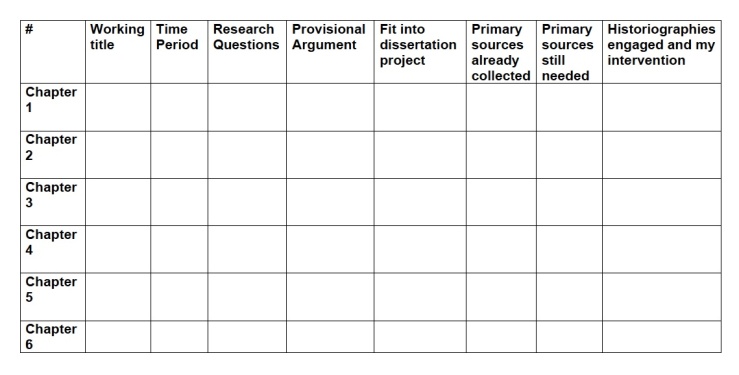In December, having finished six months of archival research, I decided it was time to get ready to write my dissertation. I was about to leave for Mexico City, and I set a goal for myself: in addition to researching while in Mexico, I wanted to have one chapter drafted and a solid plan for the others by the time I came back to the United States.
I had a chapter outline in my dissertation proposal, but of course, ideas change and develop as the research progresses. So I decided to make a new outline, not for my committee, but for myself. I had two objectives for this outline: it had to help me prioritize my archival research, and it had to help me figure out which chapter I should write first.
It ended up as a big chart that I am calling the Dissertation Planning Map. You can download a blank one here, but basically, it looks like this:

This chart traces out not just the chapter structure of the dissertation but also the work accomplished and still to be done to actually write each chapter. Each row is basically a chapter outline that includes the title, time period covered, research questions, provisional argument/thesis, the chapter’s relation to the dissertation as a whole, the sources to use (whether collected or not), and the secondary literature the chapter will draw from and engage with.
I spent a few weeks coming back to the chart periodically and trying to fill in all of the boxes. Sometimes I focused on a single chapter (row) or took a category, like sources already collected, and filled out the boxes for one column. I didn’t worry about how clever or well-substantiated the arguments were since no one else was going to look at it. I knew that it was provisional, and I forced myself to write something in every box.
As I filled in the boxes, I continued to adjust the chapters and actually came up with a new way to organize several chapters that I had been struggling to untangle. Something about the grid helped me figure out a part of my project that I had not been able to sort out from simply narrating the structure in the dissertation proposal.
From the sources columns, it became very clear that my top research priority in Mexico needed to be gathering sources from the beginning and end of my chronological period—I discovered that I had many, many sources for the period 1920-1950 and not so many before or after.
I also realized that it was the second chapter that would be the best place to start writing because I felt the most confidence in its “provisional argument” and already had most of the sources I would need to write it.
With this preparation done, I arrived in Mexico City knowing what archival materials I wanted to look for first, and after getting settled, a few weeks ago I took the step of opening a blank Word document and putting “Chapter 2” at the top of the page, and I started writing.
After just a few hours of work, I realized that the provisional argument from the chart needed to be modified, but it helped to have somewhere to start. As I continue to write, I also find that knowing what the other chapters will discuss allows me to focus on the current chapter’s argument: when looking at a particular event or source, I know what I do not need to say now in chapter 2 because it belongs in chapter 1 or 3.
Recently, I revisited the planning map after letting it sit for two months. Because I had done some archival research in Mexico by that point, I moved some sources from the “Still Needed” to the “Already Collected” column. I adjusted some chapter arguments. I plan to come back to the map every few months to think through structural issues and record my progress with the research.
In my own planning map as well as the blank one I am sharing, I put some extra rows to fill out later on for conference papers and journal articles. These could be versions of the current chapters or other spin-off topics that do not fit into the dissertation’s structure.
The planning map has helped me keep the big picture in mind as I am combining research and writing. Now I tag sources I find in the archive with the chapter I think they’ll be most useful for. It has made it much easier to give the elevator pitch about my project. Knowing that the project is still malleable, too, takes some of the pressure off: in April, I’ll go back to the chart again, and there will be another chance to make it work better.
Let me know if you like the idea, or if you have other ways to plan that worked well as you wrote your own dissertation.

[…] structure (sometimes it is easier to think about structure in an unstructured way as opposed to the grid format I blogged about a few months ago). My journal also serves now as a low-stakes place to pitch and […]
LikeLike
[…] wrote my first chapter last year while I was still doing research. I had my dissertation map all filled out, but it was a less-structured tip from a friend that helped me actually begin. She […]
LikeLike